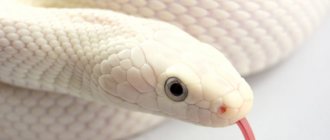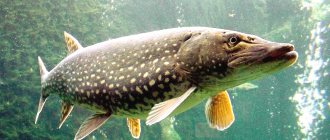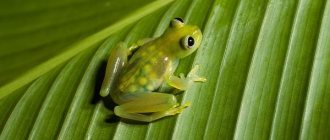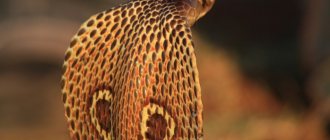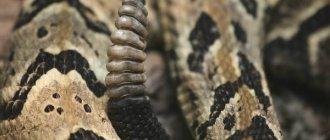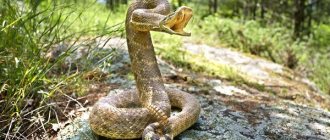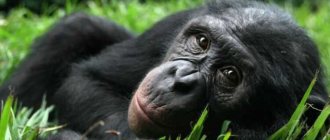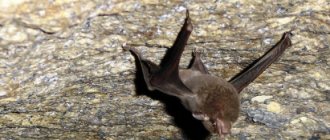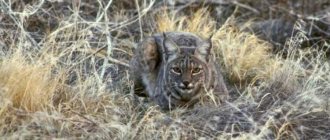SNAKES
(Serpentes, Ophidia) - a suborder of the class of reptiles.
Snakes are distinguished from other reptiles by their elongated body and the absence of paired limbs, the external auditory canal and movable eyelids. Also on the topic:
REPTILES
Each of these characteristics is also found in lizards, from which snakes (presumably) evolved in the Cretaceous period (135–65 million years ago), but together they are characteristic only of snakes. Currently, about three thousand species of snakes are known.
Differences from other reptiles
The unusual appearance of snakes and their mysterious habits have always attracted the attention of people, however, their mortal danger caused them to panic. Such a complex, dual attitude could not help but be reflected in the mythology and folklore of many peoples. At first glance, it seems that snakes are very easy to distinguish by their appearance from all other reptiles: they have an elongated body, no limbs, eyes without eyelids and covered on the outside with a continuous transparent shell, and no external ear. However, although zoologists count about 30 characteristics that distinguish snakes from lizards, almost all of them “as an exception” are also found in the latter, so these two suborders can only be reliably divided based on the totality of all characteristics.
Where are the legs?
Paleontological finds prove that in the Cretaceous period snakes still had legs. The most striking paleontological skeleton of Eupodophis descouensi was found in Lebanon in 2000, a very well preserved imprint of a snake. A skeleton in a fossil that is over 95 million years old. This ancestor of snakes with distinct limbs is believed to have lived in water.
Among evolutionary scientists, debate continues over the primary habitat of the ancestors of modern snakes. Originally aquatic or secondarily adapted to the aquatic environment? The question is still open and awaits its Nobel laureate.
Snake skull structure
Perhaps the most characteristic and consistent differences lie in the structure of the snakes' . The bones of the facial part of the skull are movably connected to each other, and the lower jaw is suspended from the skull by highly tensile ligaments. The elastic ligament also connects the right and left halves of the lower jaw. All this provides exceptional flexibility in the mouth of snakes, which allows them to swallow whole prey that is much thicker than their body. The teeth of snakes are well developed, they are relatively thin, sharp, curved back and serve for biting, capturing prey and pushing it into the esophagus, but not for chewing or tearing it. In addition to regular teeth, snakes of some families also have grooved or tubular teeth, which serve to inject venom into the body of the victim. The grooved teeth located in the back of the upper jaw are characteristic of venomous colubrid snakes. Adders and sea snakes have short, stationary tubular teeth in the front of the mouth, while vipers and pit vipers have long and movable tubular teeth mounted on a very short maxillary bone that can rotate.
Skeleton
She has a lot of vertebrae.
This makes the snake not just a crawling sausage, but a very strong and mobile crawling sausage. Therefore, Gaudí was inspired by this design for his catenary arches. Here are two pictures from my post about its architecture:
Body structure of snakes
The girdle of the forelimbs in snakes is completely absent, and from the girdle of the hind limbs, some snakes retain small bony rudiments of the pelvis, and in boas, the rudiments of the hind limbs themselves are also preserved in the form of paired claws on the sides of the anus. Due to the disappearance of the limb girdles, the spine of snakes is not clearly divided into sections, but the number of vertebrae in it is very large: from 141 in the thickest and shortest snakes to 435 in the longest and thinnest. The ribs of snakes have exceptional mobility; they can diverge widely to the sides, allowing large prey to pass through the digestive tract. The internal organs of snakes have undergone significant changes in accordance with the elongated shape of the legless body, they all have an elongated shape and are located asymmetrically; some of the paired organs lost one half and became unpaired. For example, in the most primitive snakes both lungs are developed, but the right one is always larger than the left; in most snakes the left lung disappears. The esophagus of these reptiles is very muscular, which makes it easier to push food into the stomach, which is an elongated sac that turns into a relatively short intestine.
The top layer of snakes' skin periodically peels off and shedding occurs. When molting, the exfoliated epidermis comes off first at the front end of the muzzle, and then is removed from the snake’s body with a stocking.
The nervous system of snakes is characterized by a small head and a powerful, long spinal cord, which determines, on the one hand, the primitiveness of higher nervous activity and, on the other, high coordination, accuracy and reactivity of body muscle movements.
How to run without legs?
The structure of snakes, the skeleton with its structural features, endowed these reptiles with a very special method of movement, the main role in which belongs to the scaly plates. The kinetic nature of the connection between the vertebrae, ribs and scales through muscles allows all parts to move separately from each other. This helps the snake bend in any direction and, as they say, tie itself in a knot.
At the same time, clear coordination ensures forward movement in the horizontal plane. Each flap separately becomes perpendicular to the hard surface and serves as a support for forward movement by repulsion. Muscular effort and scute by scute move the snake's body forward. Therefore, the legs of the snake are its shields.
The only thing Conan Doyle got wrong in his story “The Speckled Band” was that his snake could not climb down the cord. She would simply fall on the hero, waking him up. To move, the snake needs solid and porous support, which is why it can easily slide along glass.
The tongue and eyes of snakes
The most important sensory organ is the tongue, in combination with the paired Jacobson's organ, which is a thin chemical analyzer and has two outlets on the upper palate. snake's tongue protrudes through the semicircular notch of the upper jaw, flutters in the air for several seconds, lightly touching nearby objects with its forked tips, and then retracts inside. Here the ends of the tongue are inserted into the openings of the Jacobson's organ, and the snake receives information about minute amounts (“traces”) of substances in the air and on the substrate. Thus, by alternately sticking out and retracting its tongue, the snake quickly and confidently moves along the trail of prey, looking for a victim, a partner or a source of water.
The eyes also play a big role in the orientation of snakes, but most have poor vision; the sense of smell is very well developed and is one of the guiding senses. In sea and some sand snakes, the nostrils can be closed with special valves, which protects against the ingress of water when diving or sand when crawling in its thickness. Snakes have a very poor hearing of sounds traveling through the air, but they have thermal sense organs, or remote thermoreceptors, that allow them to sense the heat emanating from the body of their prey at a distance.
Nutrition
Snakes eat a wide variety of animals, from worms, mollusks and insects to fish, birds, rodents and small ungulates. All snakes are carnivores, the vast majority hunt live prey, and only a few species eat carrion. The diet depends on the size of the snake; Large species feed on correspondingly larger prey. The composition of food varies greatly with age: juveniles of most snakes feed on small invertebrates, and adults usually switch to feeding on vertebrates, however, small species of snakes feed on insects, worms and other invertebrates throughout their lives. Many snakes limit themselves to certain foods, and sometimes the specialization goes so far as to cause dramatic changes in the structure of the skeleton of the dental system. For example, in the African egg snake, which feeds only on bird eggs, the number of teeth has decreased and they have become small and blunt, and the processes of the vertebrae, perforating the esophagus, form a sharp “egg saw”, which serves to cut the egg shell.
Interesting Facts
- Snakes live almost everywhere, with the exception of Antarctica, New Zealand, Iceland, Ireland and some small islands of the Atlantic Ocean.
- Snakes evolved from lizards. Among living lizards, their closest relatives are the iguanas and fusiformes.
- The largest snakes are reticulated pythons and anacondas - their length can exceed 7 meters. The smallest snakes on the planet are Leptotyphlops carlae, whose length does not exceed 10 centimeters. McCoy's Taipan
- McCoy's taipan is considered the most poisonous snake in the world - the poison obtained from one individual is enough to kill 100 people. Its venom is approximately 180 times stronger than that of a cobra.
- The eyelids of snakes are transparent and remain constantly closed.
- Snakes can hibernate under unfavorable conditions.
- As of 2022, 3,631 species of snakes are known to science.
Video
snake poison
Poisonous snakes have developed a special and very effective way of killing prey. The emergence of their poisonous apparatus is associated with the ingestion of very large prey, which must first be immobilized. The poison performs this task in the most perfect way - in addition, it speeds up the digestion of the victim several times, since it destroys the tissues of its body, preparing them for absorption. The poisonous teeth of snakes of the colubrid family are located in the depths of the mouth and reach the victim’s body only when it is strongly captured by the snake’s mouth, so they are forced to hold onto the captured prey. In sea snakes, adders, vipers and pit vipers, the poisonous teeth are located in front, so that these snakes, having delivered a quick bite and injected a portion of poison into the body of the victim, can release the victim and wait for the poison to have its disastrous effect.
Snake venom is produced by the temporal salivary glands and has the appearance of a yellowish transparent liquid; it is a complex mixture of proteins that have the properties of enzymes and enzymatic poisons. Based on their toxic effect, snake venoms are divided into two groups. The first group consists of the venoms of aspid and sea snakes. Their composition is dominated by neurotoxic enzymes (cobrotoxin, etc.), which have a paralyzing effect on the nervous system. The second group is formed by the venoms of viper and pit snakes, containing mainly enzymes that destroy tissue and clot blood. Recent research has shown that poisons of the second group also contain a small percentage of neurotoxic enzymes, so fresh poison also has an effect on the nervous system. According to the enzyme composition, the picture of poisoning from snake bites of these two groups is completely different. When bitten by aspid and sea snakes, almost no lesions are observed at the site of the bite, but the phenomena of general paralysis and especially paralysis of the respiratory center quickly develop. When bitten by viper and pit snakes, local lesions predominate - swelling and hemorrhages in the bite area, in severe cases spreading to most of the body; a severe disruption of the circulatory system occurs, accompanied by enormous internal blood loss and a sharp drop in blood pressure.
Reproduction
Snakes reproduce either by laying eggs or by giving birth to live young. Pythons, many colubrids and slates are oviparous, and the vast majority of sea snakes, vipers and pit vipers are ovoviviparous. By ovoviviparity, in contrast to true viviparity characteristic of mammals, is meant the birth of live young, which were in the mother’s body in egg shells and were not connected by blood vessels to the mother’s body. There is a smooth transition between oviparous and ovoviviparous species: some lay eggs in the first stages of development, others with well-developed embryos, others with cubs ready to emerge from the egg, and finally, fourths give birth to live snakes that emerge from the egg while still in the body mother. Ovoviviparity is associated with the need to preserve the clutch inside the mother's body under unfavorable conditions, when the laid clutch would die. That is why ovoviviparity is most typical for sea snakes, as well as for inhabitants of high latitudes and mountainous regions, where the soil temperature is not sufficient for the normal development of the egg. The eggs of all snakes are covered with a soft, leathery shell. The snake buries them in foliage, loose soil or manure, where there are temperature and humidity conditions suitable for development. Most snakes then do not show any concern for the clutch, however, some species rake from the foliage or dig out “nests” and guard the eggs laid there (American mud snake, king cobra, mountain keffiyeh). In pythons, even “incubation” of the clutch is observed. The female wraps around the clutch of eggs, and her body temperature rises due to small muscle contractions by 10-15° compared to the environment, which ensures faster development of the eggs. “Incubation” lasts one to one and a half months, during which the snake does not eat anything. In the common viper and some species of sea snakes, even the rudiments of true viviparity have been discovered: their embryos located in the egg are connected by a network of the finest blood vessels to the parent organism and receive additional nutrition from it (this formation can be called a primitive placenta).
Lifestyle.
All snakes are predators, many of them can capture prey that is significantly larger in size than the snake itself. Typically, small and young snakes feed on worms, mollusks, insects, some on amphibians, reptiles, birds, fish, rodents and larger mammals. Several months may pass between two meals.
In most cases, snakes lie motionless, lying in wait for prey, and then rush at it with amazing speed and immediately begin to swallow. Poisonous snakes bite and wait for the venom to take effect, while the boa constrictors wrap themselves around the victim and strangle it.
There are several ways snakes can move. Usually the snake bends in a zigzag manner and is pushed away by parts of its body adjacent to the ground. In the desert, snakes use the so-called “lateral move”: the body touches the surface at only two points, the front part of the body is moved sideways (in the direction of movement), then the back part is “pulled up”, etc. The “accordion” method of movement is distinguished by the fact that the snake’s body is gathered into tight loops, and the front part of the body moves forward. Large snakes move in a straight line with a “caterpillar gait,” clinging to the soil with their shields and straining the muscles of the abdominal part of the body.
Snakes are distributed everywhere, with the exception of New Zealand and small oceanic islands. They mastered life in the forest, steppe, desert, underground and even in the sea. The largest number of species lives in the warm countries of East Asia and Africa; over 50% of Australia's snakes are venomous.
Some snakes, under favorable conditions, can bear offspring up to several times per season, while others do not reproduce every year (for example, the Caucasian viper). The bamboo keffiyeh, found in India and Pakistan, can reproduce all year round. Like most animals, snakes have their own “mating rituals” of varying degrees of complexity. After mating, females are able to keep the partner’s sperm in an active state for quite a long time and do not need to meet the male again for new fertilization.
Usually the cubs hatch from eggs, but viviparity is also widespread (typical of sea snakes, boa constrictors, and vipers). The female develops a placenta through which the embryos receive oxygen, water and nutrients. Sometimes the female does not have time to lay her clutch, and the cubs hatch inside her reproductive tract. This case is called ovoviviparity (vipers, copperheads).
One clutch contains an average of 10 eggs. Embryonic development is dependent on temperature, so snakes ensure that the nest temperature is maintained at a high temperature and also protect the eggs from drying out.
Snakes typically live 5–10 years, with some individuals living up to 30–40 years.
Many birds and mammals (storks, eagles, crows, hedgehogs, representatives of the order Carnivores and even pigs), and even other snakes feed on snakes.
